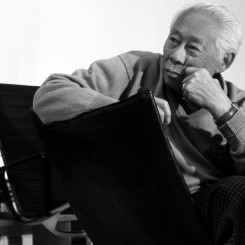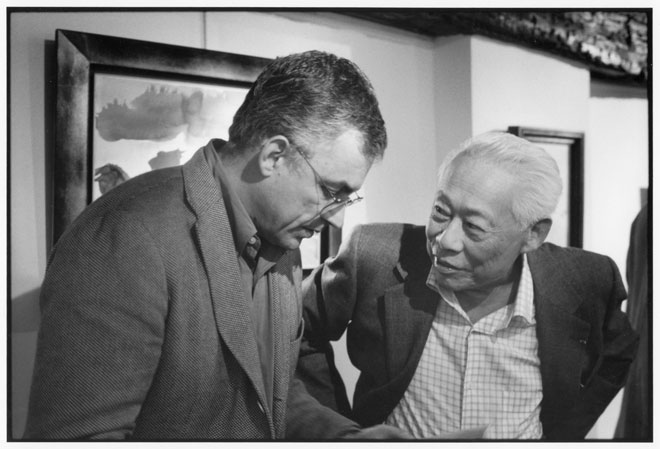Zao Wou-Ki, a French painter of Chinese origin who was born in Beijing in 1920, passed away in Switzerland on April 9, 2013. Since 2011 he had lived on Lake Léman where he spent long hours contemplating the landscape of “mountain and water” facing from his home. Zao Wou-Ki is survived by his third wife of forty years, Françoise Marquet, his daughter Sin-May and son Jia-Ling from two previous marriages.
Zao Wou-Ki was born into a literati family that could trace its origins back to the Song dynasty. At the age of 14, Zao started studying painting under Lin Fengmian, a renowned painter and the founder of the Hangzhou Academy, where Zao later taught as a young man. During his later years of study at the Hangzhou Academy, Zao Wou-Ki turned his back on the Chinese pictorial tradition which he felt had become fossilized in its own conventions. He questioned “how to represent the wind, how to paint emptiness or the clarity and purity of light.” He gradually adopted the individualistic theory of Shi Tao, who envisioned painting as the “expression of the thoughts and feelings of its creator.”
Zao belonged to the second generation of Chinese artists who went to France to study, following the example of Lin Fengmian and others who made up the first generation. In 1948 he arrived in Paris with the intention of studying the Western masters and then returning to China. But in 1949 his father, who was still living in Shanghai, dissuaded him from returning. So Zao, like other Chinese artists, stayed in France and became a French citizen in 1964.
Paradoxically, his body of work, almost entirely created outside of China and collected by all the important Western institutions, is nowadays considered to be the most emblematic of Chinese modernity. Zao Wou-Ki viewed himself as Chinese, but also possessed a sense of belonging to the world at large, and as an artist, the universe. His work reflects this universality as a synthesis of the Chinese artistic tradition and the expressive freedom celebrated in the West.
In Europe and the USA recognition and success came to him early. His discovery in Switzerland of the works of Paul Klee (1879-1940) accelerated and enriched his own path towards creative freedom. Like Klee, Zao Wou-Ki invented symbols representing subconscious levels of experience, leading to a penetrating form of artistic expression that refined his own perception of the meaning of art.
During the 1980s French institutions went through a phase of branding him as “abstract,” “decorative” or “too much of a painter.” He suffered from these mistaken qualifications, but still continued his own process of individuation, perfecting his practice on a deep-felt and intuitive level. He belonged to the art world and collaborated with numerous friends, writers, poets, musicians and architects. He worked incessantly, eight or ten hours a day on paintings, editions, lithographs and other projects. His work developed in distinct series that explore the possibilities of particular compositions, rhythms, actions and color harmonies emanating from his constant desire to devise new means of visual suggestion that become a language to describe the wind, emptiness, the passage of time, thoughts, moods, joys and pain. When asked about his artistic process, Zao Wou-Ki spoke of the moment upon waking when the lingering remnants of dreams illuminate our consciousness.
In 1983 he exhibited his work in China and in 1985 spent a few weeks at the Hangzhou Academy where he was invited to teach. In 1988 the exhibition China-Paris organized by the Taipei Fine Arts Museum offered the Chinese public their first glimpse of his work. This introduction was in the context of the “overseas Chinese artists.”
During the 1990s the recognition of his essential contribution to modern Chinese culture (mostly produced outside of China) gave a considerable boost to his works’ market. His paintings became icons in the Chinese world and in keeping with the new position of China on the world stage and economy, Chinese buyers were bringing them home.
In 2003 a retrospective organized in Paris at the Galerie du Jeu de Paume during the “Year of China in France” established him as the most important modern Chinese painter. Nevertheless, nowadays few Chinese institutions collect his works and an analysis of his market would lead one to wonder whether mainland Chinese institutions will be able to afford to collect his work.
Zao Wou-Ki kept important documentation of his work, even dating from before his arrival in France. During the 1980s, he formally entrusted his wife Françoise Marquet, a former curator at the Museum of Modern Art in Paris, with the task of documenting and preserving his work. Since then she has initiated and organized most of the important projects around Zao’s work. Aside from her recognized expertise on his work, she has published many books and surveys on various aspects of Zao’s oeuvre and is now preparing the catalogue raisonné of his work.
Zao Wou-Ki lived his life with grace. Aside from his wisdom and genius, he was also kind and generous. The American artist, Carr Patterson, who studied with him recollects on the experience: “Wou-Ki was not teaching me technique or how to paint but rather his philosophy of life, as an artist.” He told me “Being an artist is never about becoming famous. You do it because you have to, because it is your life. If you don’t love it you should not be doing it. If it is about making money or being famous, you are on the wrong path; and besides there are easier ways to achieve both.”
Maybe the artistic journey of Zao Wou-Ki and a few other artists could be seen as a parable on the relations between two great cultures. Zao Wou-Ki achieved their union even though to this day they are wary of each other. This was a first in the history of art and is unlikely to be repeated again.
__________________________________
Philippe Koutouzis had been a close friend of Zao Wou-Ki since 1992, when he moved to Hong Kong. He has studied and organized many projects around the works of Chinese painters who lived in Paris (Chu Teh-Chun, Sanyu, T’ang Haywen, Zao Wou-Ki, Yun Gee and others). He has worked as a project manager at the Musée Guimet, Paris, and has curated numerous shows about Chinese artists (Masters of Ink, T’ang Haywen, Paths of Ink, among others). More recently, he was the head of the Asian department of Marlborough gallery in New York (2003–2010). In 2010 Koutouzis opened the gallery of FEAST Projects in Hong Kong and wrote the introduction to the catalogue of the exhibition Zao Wou-Ki Beyond (Oct 2012–Feb 2013).





